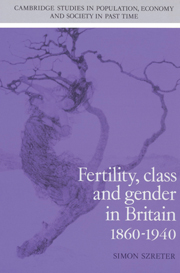Book contents
- Frontmatter
- Contents
- List of figures
- List of tables
- Acknowledgements
- List of abbreviations
- Introduction
- Part I Historiographical introduction: a genealogy of approaches
- Part II The professional model of social classes: an intellectual history
- Prologue: the fertility census of 1911 and the professional model of social classes
- 2 Social classification of occupations and the GRO in the nineteenth century
- 3 Social classification and nineteenth-century naturalistic social science
- 4 The emergence of a social explanation of class inequalities among environmentalists, 1901–1904
- 5 The emergence of the professional model as the official system of social classification, 1905–1928
- Part III A new analysis of the 1911 census occupational fertility data
- Part IV Conceptions and refutations
- Appendices
- Bibliography
- Index
- Cambridge Studies in Population, Economy and Society in the Past Time
4 - The emergence of a social explanation of class inequalities among environmentalists, 1901–1904
Published online by Cambridge University Press: 16 February 2010
- Frontmatter
- Contents
- List of figures
- List of tables
- Acknowledgements
- List of abbreviations
- Introduction
- Part I Historiographical introduction: a genealogy of approaches
- Part II The professional model of social classes: an intellectual history
- Prologue: the fertility census of 1911 and the professional model of social classes
- 2 Social classification of occupations and the GRO in the nineteenth century
- 3 Social classification and nineteenth-century naturalistic social science
- 4 The emergence of a social explanation of class inequalities among environmentalists, 1901–1904
- 5 The emergence of the professional model as the official system of social classification, 1905–1928
- Part III A new analysis of the 1911 census occupational fertility data
- Part IV Conceptions and refutations
- Appendices
- Bibliography
- Index
- Cambridge Studies in Population, Economy and Society in the Past Time
Summary
Introduction: the National Efficiency crisis
In the previous chapters it has been shown how it was that the GRO pulled back from launching a new official social classification scheme for the 1891 census after an initial expression of interest in the mid-1880s. It had become clear during the intervening few years that such an innovation was both likely to undermine the Office's long-standing autonomy in utilising its vital statistics for medical, epidemiological purposes and was also certain to provide intellectual ammunition for other, competing ‘schools’ of empirical social science that had emerged during the course of the troubled 1880s. They offered diagnoses of the causes of and remedies for urban poverty and disease that rivalled those of the environmentalist public health movement, to which the GRO continued to owe its primary allegiance.
In this respect relatively little had changed by the late 1890s, when preparations for the succeeding census of 1901 were beginning to be made. Financial restraint was still the order of the day in central government and especially at the closely-watched LGB; the main departmental rival for the GRO's control of the census – the Labour Bureau of the Board of Trade – was stronger than ever, having become a fully fledged Department in 1893. The segregationist proposals of Marshall and Booth regarding rural labour colonies had now become an experimental reality, enjoying something of a vogue among several important social work institutions, such as the Salvation Army, the Church Army and the Home Colonisation Society.
- Type
- Chapter
- Information
- Fertility, Class and Gender in Britain, 1860–1940 , pp. 182 - 237Publisher: Cambridge University PressPrint publication year: 1996



